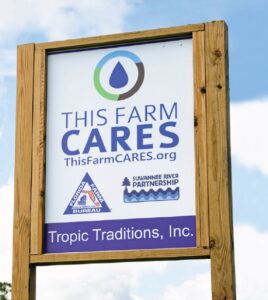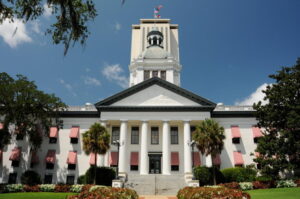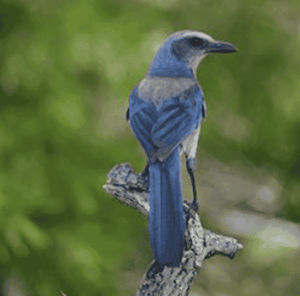Tropic Traditions Adds Pond Project and Xeriscaping to Reduce Water Usage
BY STAFF REPORTS

Near a tranquil pond stands a great blue heron and a pair of white herons feeding in the shallows.
“They’re here because I stocked the pond with fish, and I’m sure they’ve been eating their fill,” Jim (James) Fleming, owner of Tropic Traditions Nursery, a wholesale plant nursery in Newberry, Fla., explains with a smile.
What those who drive by Tropic Traditions Nursery in Alachua might not know about the beautiful pond alongside the road is that it is manmade. It is an example of an alternative water supply project completed in conjunction with Florida Department of Agriculture and Consumer Services (FDACS), Suwannee River Water Management District (SRWMD) and Tropic Traditions itself.
The pond captures rainwater and stormwater runoff to use for irrigation for the nursery instead of groundwater, and it has the capacity to conserve 24,000 gallons of water per day. It also incorporates what is known as xeric landscaping — “xeriscaping” is landscaping that uses native plants in the right climate to decrease the amount of irrigation needed.
“This project reduces groundwater pumping by providing an alternative water supply source for the landscape nursery irrigation,” said Kris Eskelin, senior project manager for SRWMD.
Fleming, who previously lived in South Florida, understands the challenges population growth can mean in terms of pressure on the water supply. This is why he jumped at the opportunity to apply for the cost-share program with SRWMD to help fund the pond project when he learned about it through the Florida Department of Agriculture and Consumer Services. With a perfect “low area” onsite at the nursery to use for a holding pond, Fleming says he applied and received a grant which helped pay for the required engineering study.
Perfect Pond Placement
During the process — in which the Florida Department of Agriculture and Consumer Services assisted in the planning and development of the project — an engineering firm took bore samples to ensure the ground was solid enough to hold the liner and the volume of water in the planned recharge pond. This was necessary to ensure water did not cave into the aquifer with its underground sinkhole system. Samples showed the ground in the area is stable lime rock, perfect for a retention pond.
The entire pond is lined with a special membrane to prevent infiltration. A pump and filtration system connect the pond to the existing irrigation system. The project, which was completed in fall 2021, supports the recovery of the Lower Santa Fe and Ichetucknee River Minimum Flows and Minimum levels by reducing groundwater pumping.
Reducing Reliance on Groundwater
Fleming is now able to use the runoff water from the rain and does not have to draw from the aquifer. There is a small well on the property in case weather becomes extremely dry and the pond doesn’t have enough water, but he says he has not yet had to use it. Prior to its construction, the nursery irrigated approximately 13 acres with three 4-inch wells.
“Reducing our reliance on our groundwater supplies and utilizing alternative water supplies is going to be vital to Florida as our state continues to grow,” said Hugh Thomas, executive director of the Suwannee River Water Management District. “Operations like Tropic Traditions are working and innovating to lead the industry in conservation practices that not only support a sustainable water supply but also improves their bottom line.”
Attracting Local Visitors of All Species
In keeping with Tropic Traditions’ mission to produce quality native and coastal trees and shrubs, the area around the pond has been kept native. Along the pond’s edge grows blue flag iris, a native plant grown at the nursery. Fleming says he kept the nearby live oak trees onsite for their beauty instead of cutting them down to put in more rows of nursery plants, allowing for a natural, beautifully shaded environment underneath the oaks.
The pond itself is thriving with native fish species, including channel catfish, shell crackers, bluegills, brim and gamboge. Fleming says their primary food source is mosquito larvae, which is helping keep the mosquito population down.
It is not uncommon to see a buck drinking from the pond, given the natural walkway in the back of the nursery that connects to the Dudley Farm Historic State Park. Fleming’s vision is to continue enhancing the natural, native elements surrounding the pond, in the hopes it will attract more visitors — from customers to native wildlife — who come to enjoy the space.
“We plan on planting native saw palmettos all the way round the pond along with some native grasses,” added Fleming, noting the resourcefulness of the whole project. “We’ve already planted blue flag iris on the perimeter of the pond because these are all native plants that we grow in the nursery, and we are able to harvest the seeds. So, we’re going to plant our own seed source around the pond.”
For more information on this and other projects, visit MySuwanneeRiver.com.





















